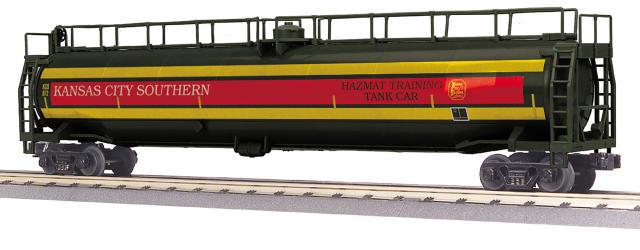
2023 O Gauge RailKing 33K Gallon Tank Car Announced
July 11, 2023 - M.T.H. Electric Trains will be releasing the 2023 RailKing O Gauge 33K Gallon Tank Car in five different livery schemes this Winter. Each of these offerings are limited in production and expected to begin shipping to M.T.H. Authorized Retailers in January 2024.
PROTOTYPE HISTORY
The tank car was relatively uncommon until the 1870s, when the nascent petroleum industry ordered large quantities of metal tanks carried on wooden car bodies. By the early 1900s, a standard design had evolved that lasted throughout the steam and early diesel eras: an 8,000-11,000 gallon metal tank perched on a metal flatcar-like underframe.
The one big change during that time was the transition from riveted to welded construction, beginning in the late 1930s. Car builders introduced X-ray inspection of welds to ensure safety, as well as giant annealing ovens that could heat-treat assembled tanks to relieve joint stress. Welded tanks were stronger, less susceptible to rust and corrosion, and less likely to rupture in the event of a wreck.
At the same time as steam engines were disappearing, another innovation completely changed the appearance of tank cars. Beginning in the mid-1950s, a new design took hold: the tank itself became the structural backbone of the car, eliminating the need for a full-length underframe and making bigger tank diameters possible. Stub sills under each end provided a place to mount trucks and couplers.
The prototype for this car was one of the largest tank cars in regular service, a pressurized 33,000 gallon car used for transporting liquefied petroleum gas, a byproduct of oil refining used for home and industrial heating. Another common payload for these cars was anhydrous ammonia, a highly concentrated fertilizer.
The first of these cars was built for Shippers car Line (SHPX) in 1962 by American Car and Foundry (ACF). To provide maximum capacity within the allowed loading gauge (outside dimensions), it featured a dual-diameter tank, with a smaller diameter over the stub end sills and a larger diameter between the sills — giving rise to the nickname “whalebelly.” Cars of this type were built throughout the 1960s and initially decorated in flamboyant paint schemes — until public concerns about the safety of flammable cargos led owners and lessees to opt for more subdued decoration. In the 1970s, however, the whalebelly design was largely replaced by single-diameter cars of the same capacity. Many original whalebellies served into the first decade of this century, until the end of their allowed 40-year service life.
Check out each of the offerings below.





